#Silk Yardage and Shawls
Explore tagged Tumblr posts
Text
How Do You Care About The Premium Quality Mulberry Silk Fabric, Yardage, Or Shawl?
Mulberry silk, renowned for its smoothness, luster, and durability, is one of the most luxurious fabrics in the world. It is produced from the cocoons of silkworms that eat only mulberry leaves, which impart the silk's signature sheen and softness. Ideal for creating elegant yet comfortable clothing and accessories, mulberry silk fabric lends itself to dresses, blouses, skirts, suits, scarves, shawls, and wraps.

Silk yardage refers to the length and width measurements of silk fabric, typically sold by the yard or meter depending on the location. Silk fabrics vary in quality, weight, and price according to the type and grade of silk used. Popular silk yardage types include charmeuse, chiffon, crepe, dupioni, georgette, habotai, organza, and satin.

Silk yardage and shawls are versatile, fashionable garments that can be worn in many ways for different occasions. Soft, lightweight silk adds a touch of color, texture, and style when draped over shoulders, wrapped around necks, tied at waists, or worn as headscarves. Available in a variety of colors, patterns, and designs, silk shawls compliment any outfit.
Valued for its delicate texture and luxurious sheen, mulberry silk demands gentle care to preserve its beauty. Follow these tips when laundering, storing, or wearing mulberry silk fabric, yardage, or shawls.
Hand wash or machine wash the mulberry silk yardage, shawls, and other items by using a mild, pH-balanced detergent. It will keep your mulberry silk yardage, shawls, and other items looking their best! Avoid bleach, enzymes, or harsh chemicals that could damage the delicate silk fibers, reducing their natural luster and softness.
turn your mulberry silk yardage and shawls inside out before washing. It will protect the outer surface and any embroidery or embellishment from wear and tear!
Rinse your mulberry silk yardage, shawls, and other items thoroughly until the water runs clear. Avoid wringing or twisting the silk as this can cause creases and distortions. Instead, gently squeeze out excess water or blot dry with a towel.
To avoid tangling or snagging your mulberry silk fabric with other fabrics, place it inside a mesh bag before washing.
To avoid creases and distortions, rinse your mulberry silk fabric thoroughly with cold water, without wringing or twisting, to remove any soap residue and excess dye.
Air dry your mulberry silk fabric. Hang it or lay it flat in a shaded area. Avoid it from direct sunlight or heat sources, as they can cause the color to fade and weaken the silk fibers. Remember not to tumble dry or hang your silk, yardage, and shawls, as this can lead to stretching and sagging.
When it comes to ironing your mulberry silk, yardage, and shawls, it is best to do it inside out. Use a low-temperature setting and make sure to use the steam function. Avoid spraying water or starch on your silk, as this can leave unwanted marks and stains. Go with steam ironing to remove wrinkles and give them a refreshed appearance.
Proper storage is crucial for maintaining the quality of your mulberry silk, yardage, and shawls. Find a cool, dry, and dark place to store them. Keep them away from dust and insects. use a breathable garment bag to protect your silk from snagging and fading!
If mulberry silk yardage, shawls, or other items become stained, pre-treat the spots right away. Gently dab liquid stain remover or mild detergent on the stain without rubbing. Then blot the stain with a clean cloth and rinse with cold water to avoid spreading or setting in the stain.
Now that you are a silk care expert, you can confidently wear your finest silk garments and accessories without fear of damage. For high-quality silk yardage, shawls, and more, visit Suzanne Tamar Dekel's website at https://www.suzannedekel.com/. Contact Suzanne Tamar Dekel - an internationally renowned natural dye expert and workshop facilitator at DekelDyes today! She offers exquisite, delicate silk fabrics that feel luxuriously soft and look intricately beautiful.
0 notes
Text
Okay, I've made enough "blease knit gauge swatches. Swatchless projects killedy family" posts. This post is an informational post a out gauge swatches. It will mainly be written in knitting terms because that is my main craft but it applies to crochet too. Even if you're an experienced crafter, you might learn something from this post. I talk about different reasons to make a swatch and some reasons a swatch might lie to you.
What is gauge?
Gauge is the size of your stitches, ie how wide and tall they are. It can be affected by the way you hold the yarn, your tension, and your needle/hook size. In knitting the style you knit can affect this, with the tendency being that English style is usually, but not always, tighter than continental. When I went from knitting English style to knitting Norwegian style, my gauge drastically changed to be much looser.
What is a gauge swatch?
A gauge swatch is a small piece of work that you use to measure your stitches per inch and rows per inch gauge. "Standard" gauge swatches are 4in/10cm squares, but often you'll see different sizes, especially for lace patterns that have you test knitting a certain chart or stitch
Why do we make gauge swatches?
We make gauge swatches to check if our gauge is the same as the pattern designer's gauge. Because you want your gauge to be the same as the pattern designer's so you know your size XL sweater will actually be size XL or your six foot in diameter shawl will actually be six feet across. Or that your airy and beautiful lace will actually be airy and beautiful and not too dense or too loose.
We also might swatch if we are substituting yarns. For example, a blocked lace swatch of wool will have different dimensions than a blocked lace swatch of pure silk because silk is less stretchy than wool. So if you are substituting fibers, you want to know that you'll like the finished item and might swatch a bit of the pattern before starting in earnest so you don't waste your time making something you'll be dissatisfied with.
There's also some differences between yarns of the same fiber and same weight. Some lace weight yarn is categorized as lace weight while being 600 yds per 100g, and some lace weight yarn is 800 yds or 1000 yds per 100g. So you should knit a swatch when substituting yarn even if they are the same fiber and weight if they are different yardage per gram ratios.
Do I always need to make a gauge swatch?
I talk a lot about the importance of gauge swatches but the honest answer is no, you do not always need to make a gauge swatch. If you are making something that doesn't require a certain size or airiness of pattern, like a bag or a simple scarf, you don't need to do a gauge swatch.
How do I make a gauge swatch?
Most patterns have a simple gauge listed, such as 22 stitches by 18 rows is 4in/10cm square in stockinette. However, some patterns have an "in pattern" gauge swatch or a separate pattern/chart for their swatch. So you cast on however many stitches (I often cast on a few more than the swatch calls for, but you don't have to), and knit that many rows in whatever pattern is specifed. If it's stockinette, knit stockinette. If it's "in pattern," locate the repeating part of the pattern and knit the designated amount of rows. If there is a separate pattern/chart for the swatch, knit as directed. Bind off. Don't measure on the needle, it will lie to you.
Then, you want to treat the swatch how you'll treat the finished object. If you're not going to block the finished object, measure it as is. But if you're going to block the finished object (and most things you should tbh blocking hides so many sins), you get the swatch wet, pin it out to shape, and then leave it to dry.
THEN! And nobody talks about this step for some reason and it's been the reason swatches lied to me in the past. Unpin it and let it rest. Different people give different time amounts for this resting. I'd let it rest at least three hours but some people recommend up to a week. The reason for this resting period is that many yarns, especially wool and other animal fibers, have elasticity to them. They'll rebound back a bit. Cotton and linen will have less rebound than things like wool. I'm not 100% sure where acrylic falls on that scale since I hate the texture of most acrylics.
OK I made and blocked the swatch and let it rest, what do I do now?
Now you measure! Does your stitches/rows ratio match up with the pattern designer's? Compare your gauge to the listed gauge. If it is different, you need to adjust needle/hook sizes. If your swatch is larger than the given measurements, your gauge is too loose and you need to go down one (or several) needle/hook sizes. If your swatch is smaller, your gauge is too tight and you need to go up one (or more) needle/hook sizes. At this point you can say "it's probably just one size up/down" and start your project, or you can repeat the entire swatch process. If unsure, repeat.
That's cool, can we see an example?
Sure! Here are two swatches I have pinned out.

I didn't follow my own advice about swatching and just started the Sapphira Lace Shawl on the recommended size 4 needles, but I got all the way through the first repeat of the body chart and then frogged the whole thing because my gauge was so loose you couldn't even see the pattern.
The Sapphira Lace Shawl has a separate pattern just for the gauge swatch and says "gauge is not important, swatch in lace pattern and use comfortable needle size to achieve airy lace that is not too holey." Too holey means that the stitches and yarn overs are so loose you cannot properly make out the pattern at all. That's what happened when I used size 4 needles.
The swatches you see here were knitted on size 2 (top) and 3 (bottom) needles. I knitted the bottom swatch first but was unsure if I liked the result so I went down another needle size and knitted a second swatch.
You'll notice the size 2 swatch is smaller and it's easier to make out the design. The stitches are smaller and denser, so the places where decreases and plain knit stitches are grouped together are easier to see. Versus the size 3 swatch where the stitches are looser and it's a bit harder to make out the design, though not impossible. On size four needled my stitches were so loose you couldn't really make out the design at all. With these swatches pinned out, I personally like the size 2 swatch better. However! That may change once I let the swatches rest for a while!
This yarn is an alpaca/silk mix. Alpaca is known for stretching out and not holding its shape. It's not ideal for lace. Silk is very good at holding its shape, but not very stretchy. I'm hoping together they make an okay yarn for lace because separately neither is my preference for lace. It was what I had on hand that was dyeable. Alpaca has some elasticity so it will spring back once I unpin it and let it rest. At that point, I may like the size 3 swatch better. I won't know until I get there.
I'll try to remember to post pictures of the rested swatches tomorrow to show if there's any difference. I might work up another swatch on size 4 needles to show what "too holey" looks like but that's more of a "how to knit lace" educational swatch than a "how to knit swatches" educational swatch so I might not bother.
That's it, that's the post. I'm sure my knitting mutuals will have comments and things to add so check the notes.
1K notes
·
View notes
Text
I finally published the project for my dice roll scarf that went viral last month. If you love dice games, you'll enjoy knitting this pattern.
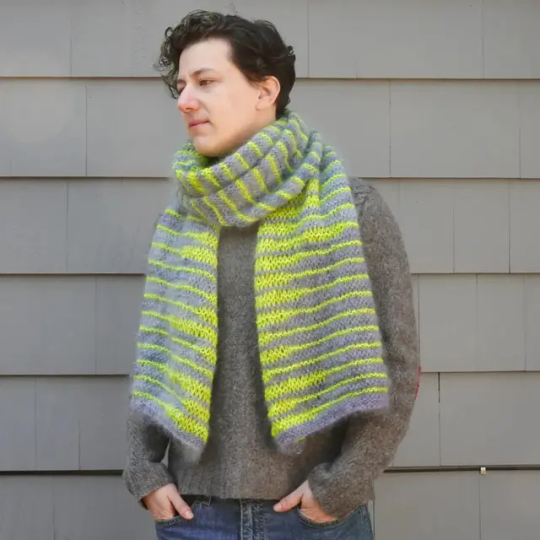
The color work in this project is determined by an algorithm, a set of rules that determine the final outcome. There isn't an exact set of instructions for this project. Instead, the knitter uses four 10-sided dice or a random number generator to pick the length of the colorwork in each row.
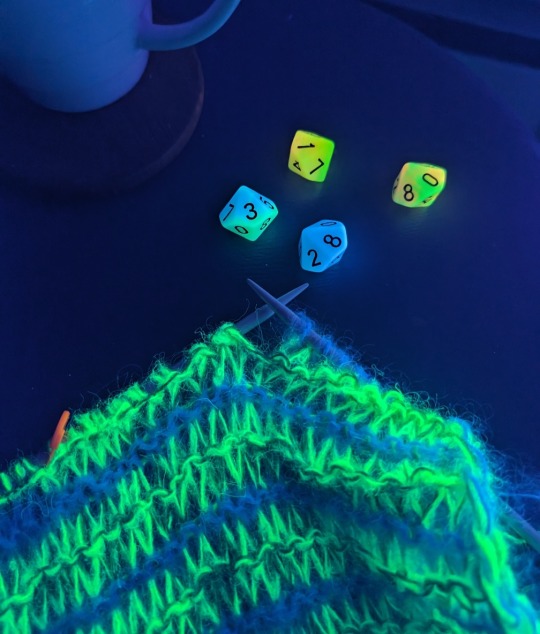
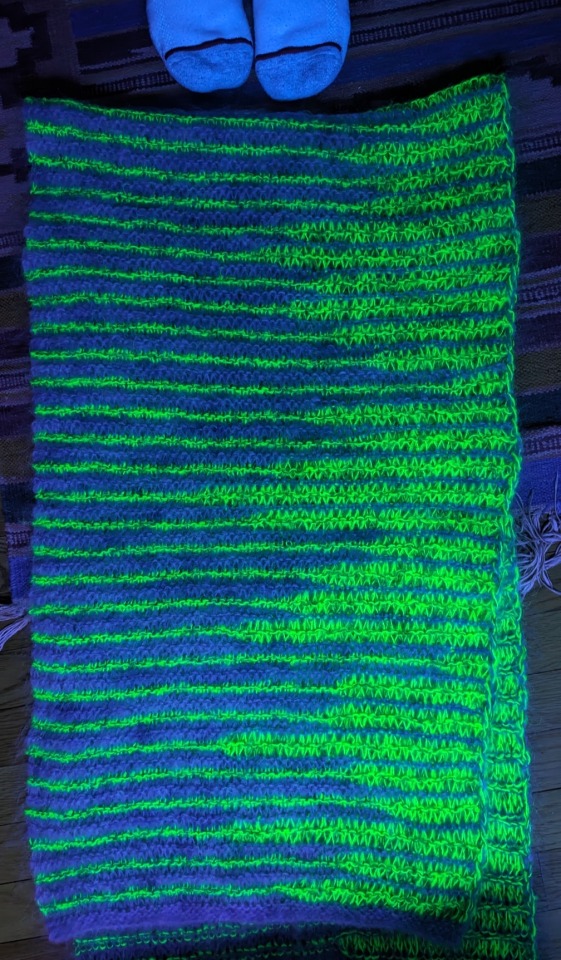
The result is a staggered stripe sequence along the edge of the shawl. There are trillions of unique outcomes, so no two projects turn out exactly alike. The pattern uses about 500 yards of yarn in total, but the amount of each color that you'll need is randomly determined. Before publishing, I wanted to find out the minimum and maximum amount of each color required to make the project and the probability of each outcome.

The knowledge needed to calculate the yardage was a bit beyond my skill level, but my friend Mary W. Martin helped me gather this info. I used an online probability calculator to find out the probability of each unique stitch count. The results are slightly different depending on whether you use four 10-sided dice (blue) or pick a random number (yellow), but 99% of all possible results fall within a very small range.
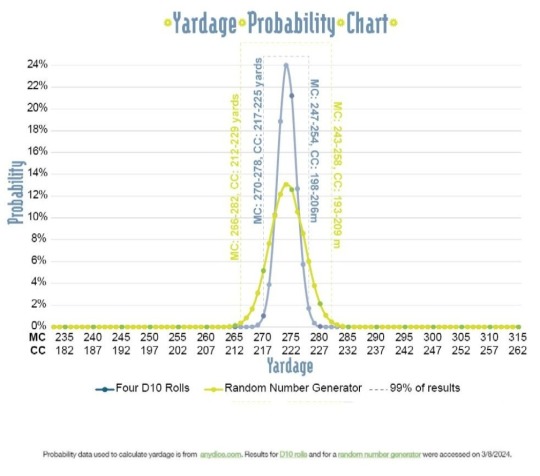
It was an interesting little tangent, but not hugely important to the actual knitting pattern. I can, however, confidently say there is a >99.9% chance that you'll need a 2nd skein of the main color. If you want to know more about the math, you should check out my project notes on Ravelry.
The thick and thin striped colorwork is created with a super simple "long stitch" technique. The pattern looks great in fluffy mohair or contrasting colors of basic wool and the instructions include some basic tips for substituting yarns or changing the gauge.

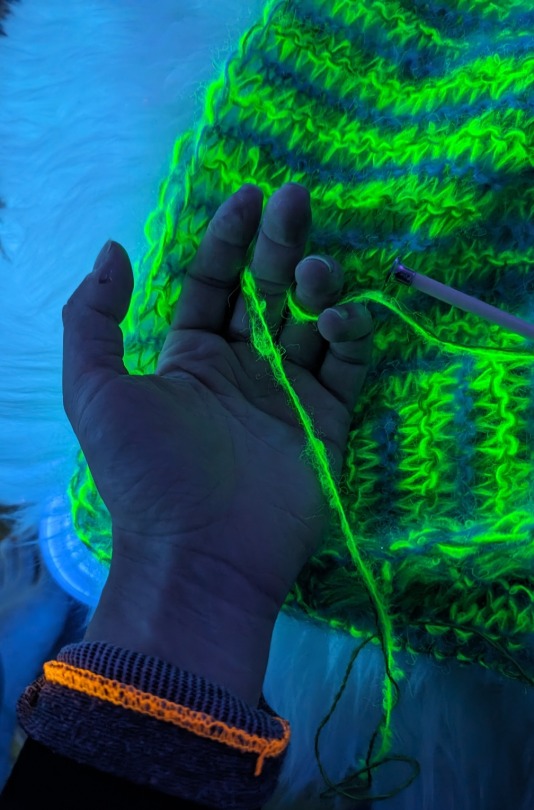
Finished Size: 18 x 68” (46 x 172 cm) rectangular wrap.
Yarn: Approx. 315 yards (288 m) of MC and approx. 264 yards (241 m) of CC. Yardage may vary, see notes on yardage below and yardage chart in photos.
• Main Color (2 skeins) - JMR Studio Worsted Weight Mohair, 245 yards (225 m) per 4 oz; 78% Mohair, 13% Wool, 9% Nylon.
• Contrast Color (1 skein each, both yarns held together) - JMR Studio Fingering Weight Mohair, 320 yards (293 m) per 100g; 63% Silk, 23% Kid Mohair, 11% Nylon, 3% Polyester Held with Lavender Lune Yarn Co. Suri Alpaca, 328 yards (300 m) per 50g; 74% Suri Alpaca, 26% Silk.
Yardage: The amount of each color used for this pattern fluctuates based on the random numbers used to determine the stitch pattern. MC uses approx. 233 to 315 yards (213 to 288m) and CC uses approx. 182 to 264 yards (166 to 241m). 99% of possible results fall within a much smaller range. The Yardage Chart shows the distribution of all potential yardage outcomes.
Needles: Size 8 (5 mm) straight needles, or size needed to obtain gauge. NOTE: Straight needles work best with long stitches. Circular needles with a thin cord allow the long stitches to tighten and stretch, making them harder to manipulate.
Gauge: 12 sts x 14 rows = 4 x 4” (10 x 10 cm) square in pattern.
Other Materials: 10 sided die or random number generator, stitch marker, scale, tapestry needle.
Generating numbers: In my sample, I used four ten-sided dice (D10) to choose a number between 4 and 40 sts. If you don't have dice, you can use an online app like RANDOM.org to generate your numbers. If you follow this link, you'll get a list of 63 integers between 4 and 40. NOTE: Each time you visit the link or refresh the page, the list changes. You can also just choose numbers as you knit.
Pattern is available on my website and on Ravelry.
841 notes
·
View notes
Text














I didn't count yardage for this guy so I'll have to update that later but! This is a lovely blend of 68% SW Merino 14% Sari Silk 9% Cashmere 9% Nylon. It's around 130g's and I chainplyed it for a sport-ish weight yarn. I think it might fluff up a bit more when I wash it, and I'd really like to hopefully find some of my other purple rovings that might match enough to make a fade type of shawl for mommy. If not that, it's still more than enough to add with another colour and use this for some nice colourwork or something. Well anyways I'm rambling.
107 notes
·
View notes
Text
Fiber arts update!
Finished the 200g/7oz of Shetland in record time! This is gonna get combined with the pink/blue Shetland/Silk from a couple months ago for a nice, warm granny shawl.
Pre-washing:
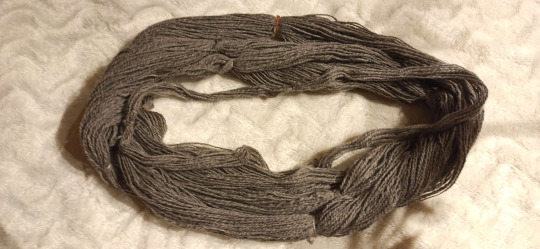
And all washed, dried and wound up!

And now I'm almost a third through spinning the rest of my "Polarfuchs"/iceland wool to hopefully make a hat out of!
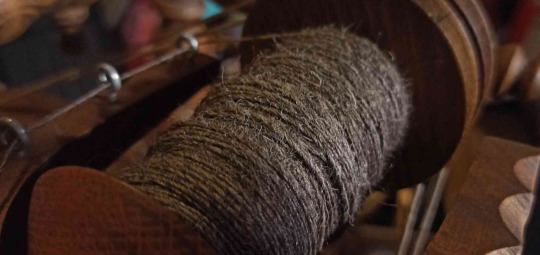
(might have to combine it with some rainbow merino or similar though depending on how the yardage works out)
It's been only a few weeks and my stash is running seriously low again...
55 notes
·
View notes
Note
You reblogged a dewy spiderweb photoset the other day and commented you made a shawl inspired by that once. Tell us about that, do you have pictures? 👀
I DO ACTUALLY okay so like here's the thing you gotta Understand about me, i get. Intense. about gifts. and when i had my Defining The Relationship conversation with my long-distance then-friend now-datemate (of now over four years!! i love them so much, i'm so happy :D) it happened in february of 2020, so uh. all of our travel plans were pretty immediately kaput due to covid. which meant that i was getting returns on interest on my pent-up first-meeting-in-person, and it had to go SOMEWHERE
so i uh. might. maybe. have gone slightly overboard making them a courting gift, while we waited.
they'd started using spider imagery for me as an endearment after a while of seeing the kinds of stuff i liked to make, so when i found this pattern on ravelry i got a little obsessed with it because doesn't it just vibe like a dewy spiderweb, though??


i had a good couple skeins of this really lovely llama/silk blend yarn (now tragically discontinued, RIP to juniper moon stargazer) that i had intended to use to make a cardigan for someone who ultimately blacklisted herself from my knitworthy-people list, but that's besides the point, because the POINT IS that i found myself staring at the ~1800 yards of it that i had, and the little jars of vintage wooden beads i'd picked up at a flea market ages ago, and uh. look. they didn't NOT remind me of a cute lil jumping spider when i sat them next to each other, is the thing, and the yarn was SO cozy soft, and uh
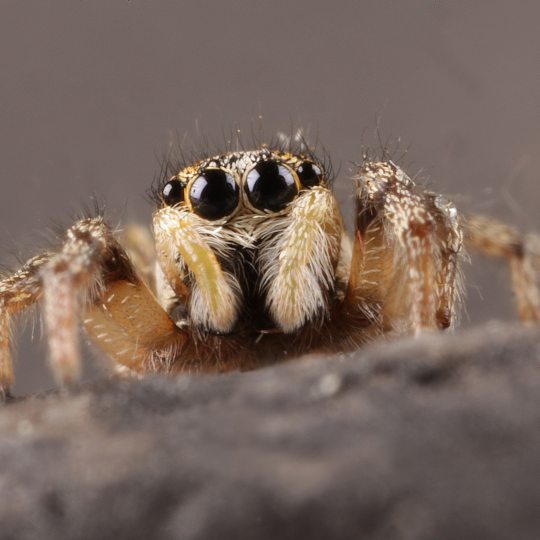

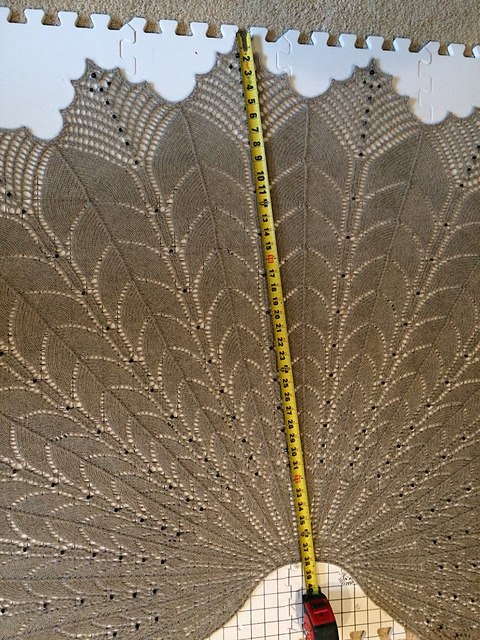
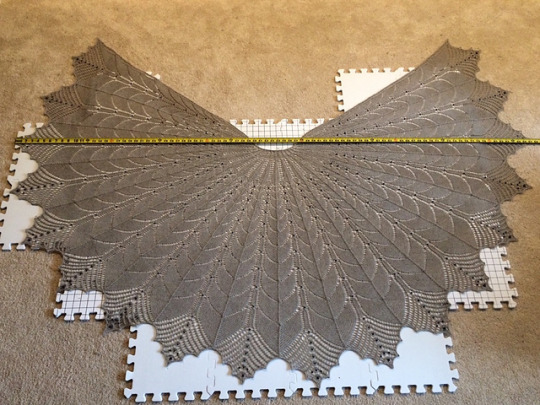

it turned out B I G
out of all that yardage i literally only had LESS THAN A FOOT left after the bind-off, so i think i pretty successfully won that round of yarn chicken XD

i ended up going even MORE overboard with gifts when i did finally get to meet them in person, because in the meantime i'd made a cedar box with fancy grain matching to put the shawl in and decided THAT wasn't enough so i packed mugs, looseleaf tea, teaspoon measure, animal tea infusers, a family friend's homemade bread, homemade plum chutney, three kinds of cheese (two of which were from the dairy farm i worked at for a year), a cutting board to put all that on, fancy chocolates from the airport, a worksheet with measurements for a sweater to make them later, and a few other odds and ends, along with pillaging the landscaping around the hotel for greenery accents XD


and the funny part is, the way the room was laid out you couldn't immediately see the bed from right inside the doorway, it's around the corner to the left, so when they walked through the door and saw all this and were like "is this your version of a trail of rose petals leading to the bed? XD" i was like "wellllllll,"

"maybe a little bit yeah :3"
and they just cracked up XD
#answered asks by cwaf#procrastiknitting#thank you for asking :DDD i love yelling about my knitting#i have a sideblog about it actually!!#tumblr @dawnthread#i'm gonna reblog this over there too
20 notes
·
View notes
Text
Soooooooooo, I'm going on vacation next week with @swords-n-spindles !!! (Very excited!!!)
And I need help deciding on a travel/vacation project
We have left to right:
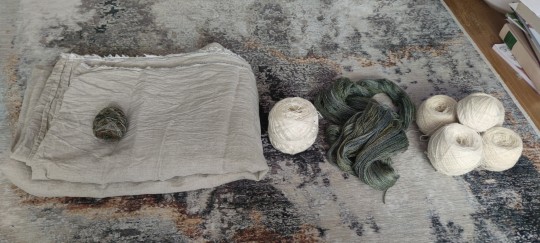
1. Linen fabric for a pirate shirt with lace on the sleeve cuffs. (Needs to be pressed first) (I could use some fabric that might be over for some drawn lace work with the lace yarn I spun some while ago 👀)
2. 425m of wool, silk and Ramie. My little niece still needs a plushie
3. Unknown yardage of tussah silk for a summer lace sweater (have a few patterns in mind, very simple, might be dyed over)
4. 720m of 2ply lace/cobweb. The first raw Fleece I worked with. Not too soft. Might be able to be worn next to skin, not Shure. Maybe also a lace sweater? Or a cute lace shawl?
(I lean towards two projects. One for the train, and one for the vacation flat)
82 notes
·
View notes
Note
imagine: you have a 100g/360m skein of the softest most beautiful baby alpaca cashmere silk 4ply/sock weight yarn in a super pale cream colour. you’re never going to hand wash socks. what do you make?!?! you are my personal knitting influencer please guide me <3
omg !! first of all you are right to not do socks with it, alpaca has a tendency to grow lengthwise even when knit at tight gauges. but this is actually great for garments and other accessories—the drape on that fiber blend will be gorgeous!!
360m is a little light for a tank top, unless your bust size is under ~34-36 in. with my 40" bust i usually need 120 g of sock weight yarn, and that's usually w. yarns that average ~400m a skein! this skein sounds like its more in the sport / heavy fingering range for its yardage, so i am keeping that in mind when browsing rav for you.
for such a luxurious fiber blend, i would look at scarves and shawls first, hats second. because i'd want that shit right up against my skin! here are some things i found doing a ravelry search for <300yds, fingering or sport weight, no socks / other feet accessories:
here is a free shawl pattern with a ton of details, size options, and yarn weights that looks approachable even to lace haters such as myself
here is a lovely single skein scarf, also with some manageable lace; or a cowl if that's more your style
i recently knit some fingerless gloves that i'm really excited to wear while smoking weed on my patio? if that's something that you would get use out of, here are a couple cuties: [x] [x] [x]
for hats i would go with something slouchy over something more fitted, these are cute: [x] [x]
finally, if none of those are really grabbing you, might i suggest pairing this one fancy beautiful yarn with larger quantities of something a bit more basic for a color work garment? the alpaca+cashmere of your new yarn will have a really pretty 'halo' to it that would look great against a contrasting, normal-ass plied merino with good stitch definition from a brand like berrocco, rowan, or knitpicks. here are some absolute stunners:
a geometric banger
moody + reflective
sheafs of wheat chic
i would personally never do a sweater on US 2 but the BIRDS on this one are soooo pretty
a slightly more reasonable birds sweater
and this vest from a designer i am itching to knit something from in 2024
#knitting#i love these asks sm#the sheafs of wheat in cream against whatever jewel tone looks best against ur skin ?? hello#or that scarf#im so excited for u pls lmk what u pick
11 notes
·
View notes
Text
I have just finished plying my most recent project. I’ve mixed a bit of the January Paradise Fiber’s fiber of the month (Simply Socks, undyed, a mix of Targhee wool, silk, and bamboo) with the March Fiber of the Month Once Upon a Time mix (Merino wool with Stellina acrylic sparkles). I also added a third type of lace-weight yarn that I got from my local yarn store, called Premier Yarn Enchant (I forgot to take a picture of this beforehand, but that is where the purple sparkles and the flower-shaped sequins come from. It is basically a sparkly, sequin-studded purple floss) to make a nice three ply yarn.
The box-skewer-spool layout I have it a DYI lazy kate; the bobbins I’m using as spools are flat-pack bobbins that I ordered from etsy. It works alright, but I will need to create something to tension the yarn; both spools have a tendency to overspool v. quickly, and then I have to untwist the plys so that I can re-twist them properly. See also why my previous plys have been either chain-plyed or using the Andean plying method; two or more singles at once is difficult to work when you have a drop spindle. I definitely understand why spiders have eight legs; I want four hands just to keep track of everything.
I was really very worried about the Once Upon a time mix; the oranges, teals, and purples seem like they won’t go well together. However, after I spun them down they sort of muted out? I think this is because they’re more pastel-shaded than anything.
Still doing the wash-and-thwack steps, so I’m not sure what the final yardage will be. When you’re a more consistent spinner I know you can calculate that based on the weight, but I do it with my niddy-noddy. It is 9in from arm-to-arm, so one full wrap is about 1yd.
The lazy kate picture only contains the leftovers from my final spin; I used up the entire skein of store-bought yarn and stopped there. The skein length is supposedly 429yd, so I’m hoping my final spin will be at least 400yd. This is the most full that my drop spindle has ever been, and it was getting very hard to get it spinning by the end. I’m sorry that the final picture of it doesn’t show off the sparkles nearly as well as it should when the sun hit it.
This will likely get turned into a shawl of some sort; I do not think that the irregularly paced sequins will prove themselves good for any kind of socks, gloves, or sweater.




2 notes
·
View notes
Photo

Are shawls your main squeeze? Or maybe you simply love a TON of yardage for sweaters without weaving in so many ends? Or perhaps the luxury of shiny, soft mulberry silk is what entices you. You’re in luck! Silky Shaw Length Fingering weight and Lightly Groovin Laceweight are updated and in the shop. More colorways than I could post here, so it would be a great idea for you to go take a peek! https://www.instagram.com/p/By03qFdJPPz/?igshid=1glexmsuwensj
2 notes
·
View notes
Text
A rehabilitation venture for the differently-abled children of tea estate workers in Munnar turns 25
New Post has been published on https://apzweb.com/a-rehabilitation-venture-for-the-differently-abled-children-of-tea-estate-workers-in-munnar-turns-25-2/
A rehabilitation venture for the differently-abled children of tea estate workers in Munnar turns 25

Workers in navy blue uniforms at Aranya Naturals’ dyeing unit at Nallathanni in Munnar are busy. A row of tables splits the high-roofed space into two; on one side are water-filled basins over which women, wearing gloves, stir the contents. On the other side, inside a glass enclosure, eight women sit around a table tying thread around fabric for shibori; while at the far end 12 metres of indigo dyed fabric suspended by a winch hang over a steel drum. “The drum holds 2500 litres of indigo dye,” guide and floor supervisor, the ever smiling Bhanumathi K says.
Each of the 37 people working here has been affected by a physical disability — hearing and/or speech impairment or other challenges. Together, they create Aranya fabric, which travels across the country and the world from Sri Lanka to Los Angeles and California.

Aranya, which just turned 25, is one of Munnar-based Srishti Trust’s projects. Srishti, backed by Tata Tea Limited (now Tata Consumer Products Limited), has been working with the differently-abled children of estate workers since 1991 and Aranya was formed in 1994. It grew out of an idea that Srishti Managing Trustee Ratna Krishna Kumar had after attending a dyeing workshop. (Ratna’s husband RK Krishna Kumar was the Managing Director of Tata Tea Limited, when it launched.) Right from get go Ratna says she was clear that the project would be for the differently-abled children of estate workers and their rehabilitation.
One of the team’s first clients was Polo (Ralph Lauren) for whom they dyed georgette, silk and chiffon (for dresses). Today, ‘Amari’, the boutique attached to Aranya proudly showcases shawls, stoles, yardage and garments fashioned out of tie-dye, in varied patterns of shibori and itagimi. It is set in a large campus, surrounded by gardens, which the team moved into in 1996. However, the project began in an abandoned shed in Tata Tea’s Nettimudi estate, when the team, turned the space into a lab, using mud pots and a wood-fired stove. These experiments grew into Aranya Natural.

How it began and sustained for a quarter century is an interweaving of lives and stories. If the genesis lay in Ratna’s idea, it was carried forth, with her and Tata Tea’s support, by people such as Victoria Vijayakumar who co-ordinated activities over the years and the differently-abled, like Bhanumathi, who has been with the team for 25 years.
Bhanumathi says she came to Aranya as an 18 year-old, “a Class 10 pass”, in her own words, “with two club feet and nothing much to look forward to.” She tears up speaking of how her life changed because of her work: she is married and has a son, a Class 10 student of the High Range School in Munnar. Most importantly, she is able to support her aged parents. Bhanumathi was among Aranya’s first four employees and the only woman then.

The cheerful co-ordinator Victoria Vijayakumar, Vicky Ma’am to the ‘children’, became part of Aranya serendipitously. She was the translator for the introductory dyeing workshop by Darshan Shah.
“I was translating from English to Tamil for the workshop. I had to focus completely on what was being said, because if I didn’t I would mislead the children,” she says. At night she would pore over the dictionary to check if she got the terms right. “By the end I knew enough about dyeing to become part of Aranya.” She remembers the initial days of trial and error, when along with Ratna she and new recruits would experiment, “the water here has many minerals which makes it ideal for this activity,” she says.

The fledgling venture experimented for two years before they started getting their first orders. “By then we felt confident enough. One of the first orders, if I remember correctly, was for saris. Initially it was a nightmare, but we got it right,” says Victoria. Most of the fabric is made to order, therefore the quantity produced varies. Some of the labels they work include Barefoot (Sri Lanka) and Eileen Fischer (New York). They also work with designers, including Kochi-based Sreejith Jeevan, Mumbai-based Riddhi Jain and Sunitha Shankar from Pune.
Raw material, for most of the dyes, is natural and local. Tea waste, eucalyptus grandis, eupatorium (Nilgiri kozha) and ageratum are some of the plants from which the dyes are made. A lot of these come from the forest floor. “We use things that will not be of any other use like barks of trees,” says Victoria Vijayakumar. Fittingly, they also use tea waste since Munnar is tea country. The tea that spills over in the factory during the processes, which would otherwise be discarded, is collected, boiled and made into beige coloured dye.
There is constant focus on training. Victoria has travelled with some of the workers to seminars and workshops across the country, as well as to the United States, the United Kingdom, Malaysia, France, Italy and Japan.
P Arumugham smiles shyly as Bhanumathi introduces him. She holds up a sample of ‘Aru shibori’, his innovative take on traditional Arashi shibori: although patterns are set the team is encouraged to experiment. Japanese dyeing expert Yoshiko Wada, who works with Aranya Naturals, impressed by Arumugham’s creation, named it ‘Aru shibori’.
The pay-off for Ratna, Victoria and everybody else involved is the transformation on the faces of Bhanumathi, Arumugham and others. That look on Arumugham’s face when he explains how Aru shibori is done.
Aranya Natural is at Nallathanni (Munnar) ahead of the KDHP Tea Museum alongside Athulya (hand-made paper unit) and Nisarga (strawberry/fruit preserve unit), which are among Srishti’s other projects. Log on to www.aranyanatural.com for information or to order fabric online. It is open to visitors from 9 am – 5 pm except on Sundays; contact 04865-230340
Source link
0 notes
Text
Finally, an ealy lovable soft comfy 💜silk💖 post!
Remember a few months ago after the election when I finally broke down and bought a bolt of 12-momme charmeuse silk to dye and make new clothes from? Well, I haven't got round to doing anything with it yet, but I have got round to buying my first hank of silk yarn to dye. Yes, I'm probably getting ahead of myself here, since it's not like the dining room is the least bit ready to become the sewing/crafting and TV room that everyone at the SpaceCastle eventually wants it to be, but I couldn't resist. I was bumming around on YouTube several days ago and happened upon some reviews of knitting machines, and found out that the most recent version of the Singer knitting machine — which is made for kids at a price their parents can afford — doesn't suck nearly as much as its predecessor did. Indeed, you can't make anything actually *nice* with it, but you *can* make sock blanks which by their very nature don't need to look good since they're going to be dyed and then eventually unraveled when the yarn is used for making actual socks, or hats, or shawls, etc. So I broke down and bought one, since I knew that sock blanks are expensive and they don't come in the yarn you just spun yourself. (Yes, eventually, I'll start spinning again and will want to dye said yarn myself, sometimes in a hank and sometimes using the sock-blank method.) I got the undyed silk yarn — which will arrive sometime in the coming week — from KnitPicks, since I was ordering a set of interchangeable knitting needles and needed to add something else to my cart to get the free shipping. It looks lustrously smooth and soft, so will knit up into a sock blank nicely. Next I need to get some acid dyes from Dharma Trading Company to try out on the silk yarn, and if they turn out as expected, then I'll have a pretty good idea of which dyes produce what shades and can make a better guess before committing any yardage of the silk fabric I got back in November. comments from Autistic Ace dragon flying in the wilderness http://ift.tt/2lPn8kH via IFTTT
5 notes
·
View notes
Text
Occupational Therapy Playground - Episode 592 - The Knitmore Girls
This week's episode is sponsored by:
Carry your creativity with Erin Lane Bags! Whether you show your fiber fandom with the woolly wonder
Sheepleverse, or dive into history with the Curiosities collection, our project bags, totes, and hook and needle
organizers are at the ready to keep your hobby happy.
Go to HelloFresh.com/80knitmore and use code 80knitmore to get a total of $80 off, including free
shipping on your first box. Additional restrictions apply, please visit HelloFresh.com for more details.
When was the last time your knitting yarn was a work of art?
Infinite Twist produces one-of-a-kind semi-solid gradients featuring speckles, high-lights, low-lights, and gorgeous color transitions. From 700 y Giant Gradients to 200 y matching sock sets, Infinite Twist Gradients will hold your interest from cast on to bind off.
See the currently available gradients at infinitetwist.com, or be the first to know when new colors are posted by signing up for our newsletter at infinitetwist.com/newsletter-signup
Books plus knitting plus happy memories. That’s Little Skein in the Big Wool. We make kits, yarn and project bags that bring your favorite stories to life. Find *your* favorite story at littleskein.com
Have you ever had to frog because you forgot a step several rows back? Or lost your spot because you dropped your magnet board or lost track with your highlighter tape? Instead of wrestling with paper, use the knitCompanion app. It keeps you on track so you can knit more and frog less. knitCompanion works with ALL your patterns and is available for apple, android and kindle fire devices.
LoLo Body Care, formally Bar-Maids, creates exceptional moisturizers hand-poured by staff who add a good dose of heartfelt love to each one. Most all their supplies are made in the US, and their beeswax sourced from a local farm. Besides quality, the value of their product lies in that they last a very long time and are loved to the very last bit. They built their brand on being eco-friendly and their new packaging rocks. Their customers and customer service are rare and treasured jewels.
PRONOUNs
One minute PUPdate: Han's GoFundMe link
On the Needles:(4:44)
Gigi working on the second pair of Hue Loco knee high socks:
Jasmin is making steady progress, 3rd to last stripe on her Match and Move shawl
(by Martina Behm #behmalong); knitting it in Black Cat Fibers Nomad Sock.
Gigi kitchenered two Xmas socks, cast on another one in purple
Jasmin started the Baby Bandit by Jacqueline Cieslak test knit, in Little Skein Harvest Sport Sugar Maple
for Genevieve.
Gigi knitted on the (RAVELRY LINK) Flickering shawl out of grey and Styx in
Lisa Souza Dyeworks Deluxe Sock. She is working on that at Jasmin’s house.
Jasmin reknit two of the three swatches. For the (RAVELRY LINK) Humo Amargo Cardigan
Gigi is done with the (RAVELRY LINK)Treppenviertel cowl in Alexandra The Art of Yarn in the colorway
Dark Side of the Moon
Gigi worked on the Ridgeline cowl, R O Y G(BIV)
Jasmin has made progress on her emPower the People cowl in Onyx Fiber Arts DK “The Sky was purple”
Check your voter registration here. Here's the Vote Tracker
Gigi started an emPower the People cowll in Neighborhood Fiber Company DK in Remington.
Check your voter registration here. Here's the Vote Tracker
Enormous VOTE earrings LINK
contact your school superintendent about reminding students to register to vote
Events:(19:20)
The Operation Sock Drawer book will be published in October. Call Hicklebees for a PERSONALIZED, SIGNED preorder
copy of Operation Sock Drawer. Or go on their website!
Stash Dash 2020 is over, yardage TBD. #teamcuteknitter #beatbostonjen
Bay Area Fiber Fair! Ends October 15, 2020
XRX Stitches at Home
Mother Knows Best:(24:11)
Pivoting!
Gigi tells a story. Link to Jasmin's story about the spatter painting.
When Knitting Attacks: (36:20)
Gigi was doing the Ridgeline cowl with a magic loop technique. When working on the contrast color,
all the stitches slipped onto the needle and stretched out the contrast color
working on the Treppenviertel, Gigi lost the game of chicken
Knits in Space:(40:23)
Gigi is tutoring/ translating online material for an old classmate
This weeks Love to Sew Podcast ( episode is titled Free Sewing) has lots of tips for free sewing patterns
and sewing YouTube videos .
Gigi wants to sign up for a bunch of newsletters
And Sew On:(44:47)
Gigi remotely attended the first and second meeting of the tailoring class at Cañada college.
She thought her pattern was a pdf pattern. It is not. She had a Zoom meeting with classmate, her
pattern had some adjustments. Jasmin went to Meissner's for supplies.
Gigi is working on plain quilting for back of a cushion.
Gigi mentions The Complete Guide to Fitting
Gigi needs some autopilot sewing. She may start on Grinch bags
Jasmin sewed some silk masks using this pattern.
She worked at Andrew's standing desk.
Check out this episode!
0 notes
Text
Unraveled Wednesday, May 10
Unraveled Wednesday, May 10
Welcome to Unraveled Wednesday! Today, I am happy to say, there has been no unraveling and I even have a finished object! First up, Settler Shawl – okay, I don’t think I would actually classify this a shawl – more like a scarf or a shawlette perhaps, due to the yardage of my yarn choice. But, I only had one skein – I received Sterling Silk and Silver yarn from Kraemer Yarns and I have never knit…
View On WordPress
0 notes
Photo



Film Project - Research
Textile Industry
Following our visit to the Bridewell Museum last year, I found myself wanting to learn more about the Norwich Textile industry, particularly the colour element.
Norwich Red
During my research I came across the story of the Norwich red and a quote from someones relative saying how the “Rivers ran Red”. This was caused by the empting of the vats from one or more of the dyeworks in Norwich.
Michael stark (1748-1863) developed a dye using the Madder Root that could dye silk and yarn to the exact same red, this was an important development in dyeing industry at the time.
Few recipes survived due to the dyers requesting that their notebooks be burnt at their death. A recent analyse shows that the dye consisted of Madder Root, Tin Mordant and water from the river Wensum. This later became known as Norwich Red.
Madder Root
The red dye was made using the Madder root. Madder Root produces a variety of reds, brick red, blood red, and fiery reds. The colour of the root depends on the roots where grown, their age, the mineral content of the water used for dyeing, the temperature of the dye pot and how much madder you use in relation to the fibre. Adding chalk and avoiding high temperatures will acieve better reds.
What it was used for...
Shawls - Information provided by the Norwich Museum Service (Costume and Textile)
Shawl, woven by Towler and Campin, Norwich, Norfolk, silk warp, wool weft, silk and wool fillover, 2x1 twill about 1844 in scarlet, black, white, pink, yellow silk, malachite green and spectrum blue in exotic flower design with interlaced pines, plain centre, ends only of interlaced pines and sprays, sides isolated pine and sprig motifs at intervals, red silk fringe, knotted in bunches, on narrow heading, sewn on, ends only, sides hemmed. Michael Stark dye for silk and worsted wool. Design number B T43/182 PRO 21398. (images above)
Tartan for the Scottish Regiment
For a long time Norwich was the main supplier of dyed yarn used to make tartan cloth for the Scottish Regiments.
Yarns and yardage were sent to the city of Norwich from other parts of England and Scotland to be dyed in the city.
0 notes
Text
A rehabilitation venture for the differently-abled children of tea estate workers in Munnar turns 25
New Post has been published on https://apzweb.com/a-rehabilitation-venture-for-the-differently-abled-children-of-tea-estate-workers-in-munnar-turns-25/
A rehabilitation venture for the differently-abled children of tea estate workers in Munnar turns 25

Workers in navy blue uniforms at Aranya Naturals’ dyeing unit at Nallathanni in Munnar are busy. A row of tables splits the high-roofed space into two; on one side are water-filled basins over which women, wearing gloves, stir the contents. On the other side, inside a glass enclosure, eight women sit around a table tying thread around fabric for shibori; while at the far end 12 metres of indigo dyed fabric suspended by a winch hang over a steel drum. “The drum holds 2500 litres of indigo dye,” guide and floor supervisor, the ever smiling Bhanumathi K says.
Each of the 37 people working here has been affected by a physical disability — hearing and/or speech impairment or other challenges. Together, they create Aranya fabric, which travels across the country and the world from Sri Lanka to Los Angeles and California.

Aranya, which just turned 25, is one of Munnar-based Srishti Trust’s projects. Srishti, backed by Tata Tea Limited (now Tata Consumer Products Limited), has been working with the differently-abled children of estate workers since 1991 and Aranya was formed in 1994. It grew out of an idea that Srishti Managing Trustee Ratna Krishna Kumar had after attending a dyeing workshop. (Ratna’s husband RK Krishna Kumar was the Managing Director of Tata Tea Limited, when it launched.) Right from get go Ratna says she was clear that the project would be for the differently-abled children of estate workers and their rehabilitation.
One of the team’s first clients was Polo (Ralph Lauren) for whom they dyed georgette, silk and chiffon (for dresses). Today, ‘Amari’, the boutique attached to Aranya proudly showcases shawls, stoles, yardage and garments fashioned out of tie-dye, in varied patterns of shibori and itagimi. It is set in a large campus, surrounded by gardens, which the team moved into in 1996. However, the project began in an abandoned shed in Tata Tea’s Nettimudi estate, when the team, turned the space into a lab, using mud pots and a wood-fired stove. These experiments grew into Aranya Natural.

How it began and sustained for a quarter century is an interweaving of lives and stories. If the genesis lay in Ratna’s idea, it was carried forth, with her and Tata Tea’s support, by people such as Victoria Vijayakumar who co-ordinated activities over the years and the differently-abled, like Bhanumathi, who has been with the team for 25 years.
Bhanumathi says she came to Aranya as an 18 year-old, “a Class 10 pass”, in her own words, “with two club feet and nothing much to look forward to.” She tears up speaking of how her life changed because of her work: she is married and has a son, a Class 10 student of the High Range School in Munnar. Most importantly, she is able to support her aged parents. Bhanumathi was among Aranya’s first four employees and the only woman then.

The cheerful co-ordinator Victoria Vijayakumar, Vicky Ma’am to the ‘children’, became part of Aranya serendipitously. She was the translator for the introductory dyeing workshop by Darshan Shah.
“I was translating from English to Tamil for the workshop. I had to focus completely on what was being said, because if I didn’t I would mislead the children,” she says. At night she would pore over the dictionary to check if she got the terms right. “By the end I knew enough about dyeing to become part of Aranya.” She remembers the initial days of trial and error, when along with Ratna she and new recruits would experiment, “the water here has many minerals which makes it ideal for this activity,” she says.

The fledgling venture experimented for two years before they started getting their first orders. “By then we felt confident enough. One of the first orders, if I remember correctly, was for saris. Initially it was a nightmare, but we got it right,” says Victoria. Most of the fabric is made to order, therefore the quantity produced varies. Some of the labels they work include Barefoot (Sri Lanka) and Eileen Fischer (New York). They also work with designers, including Kochi-based Sreejith Jeevan, Mumbai-based Riddhi Jain and Sunitha Shankar from Pune.
Raw material, for most of the dyes, is natural and local. Tea waste, eucalyptus grandis, eupatorium (Nilgiri kozha) and ageratum are some of the plants from which the dyes are made. A lot of these come from the forest floor. “We use things that will not be of any other use like barks of trees,” says Victoria Vijayakumar. Fittingly, they also use tea waste since Munnar is tea country. The tea that spills over in the factory during the processes, which would otherwise be discarded, is collected, boiled and made into beige coloured dye.
There is constant focus on training. Victoria has travelled with some of the workers to seminars and workshops across the country, as well as to the United States, the United Kingdom, Malaysia, France, Italy and Japan.
P Arumugham smiles shyly as Bhanumathi introduces him. She holds up a sample of ‘Aru shibori’, his innovative take on traditional Arashi shibori: although patterns are set the team is encouraged to experiment. Japanese dyeing expert Yoshiko Wada, who works with Aranya Naturals, impressed by Arumugham’s creation, named it ‘Aru shibori’.
The pay-off for Ratna, Victoria and everybody else involved is the transformation on the faces of Bhanumathi, Arumugham and others. That look on Arumugham’s face when he explains how Aru shibori is done.
Aranya Natural is at Nallathanni (Munnar) ahead of the KDHP Tea Museum alongside Athulya (hand-made paper unit) and Nisarga (strawberry/fruit preserve unit), which are among Srishti’s other projects. Log on to www.aranyanatural.com for information or to order fabric online. It is open to visitors from 9 am – 5 pm except on Sundays; contact 04865-230340
Source link
0 notes